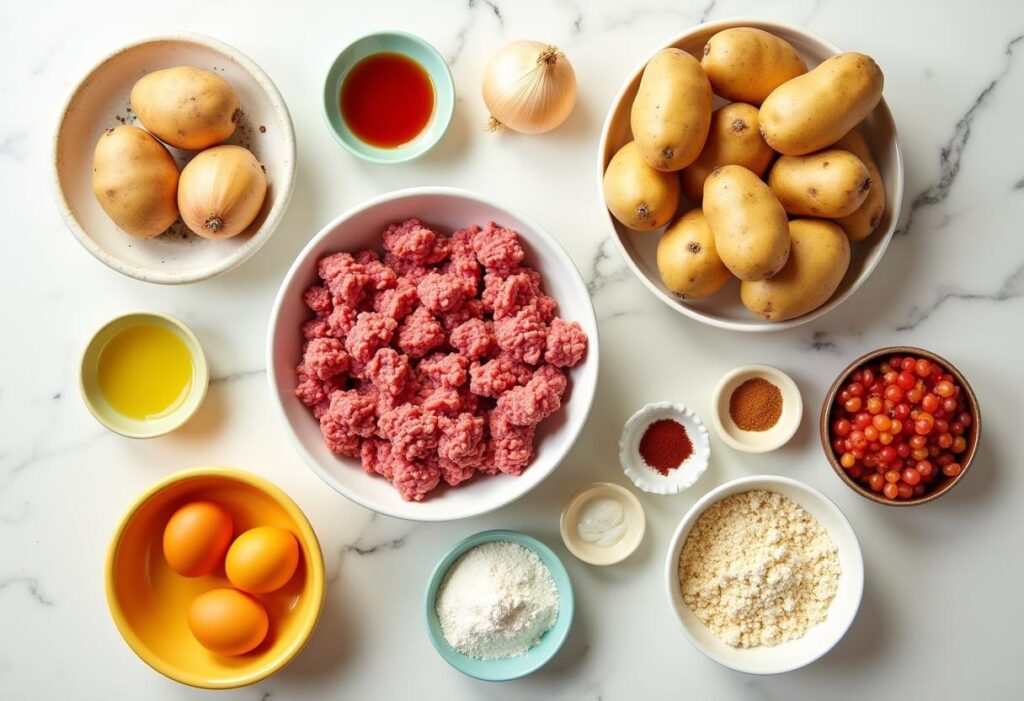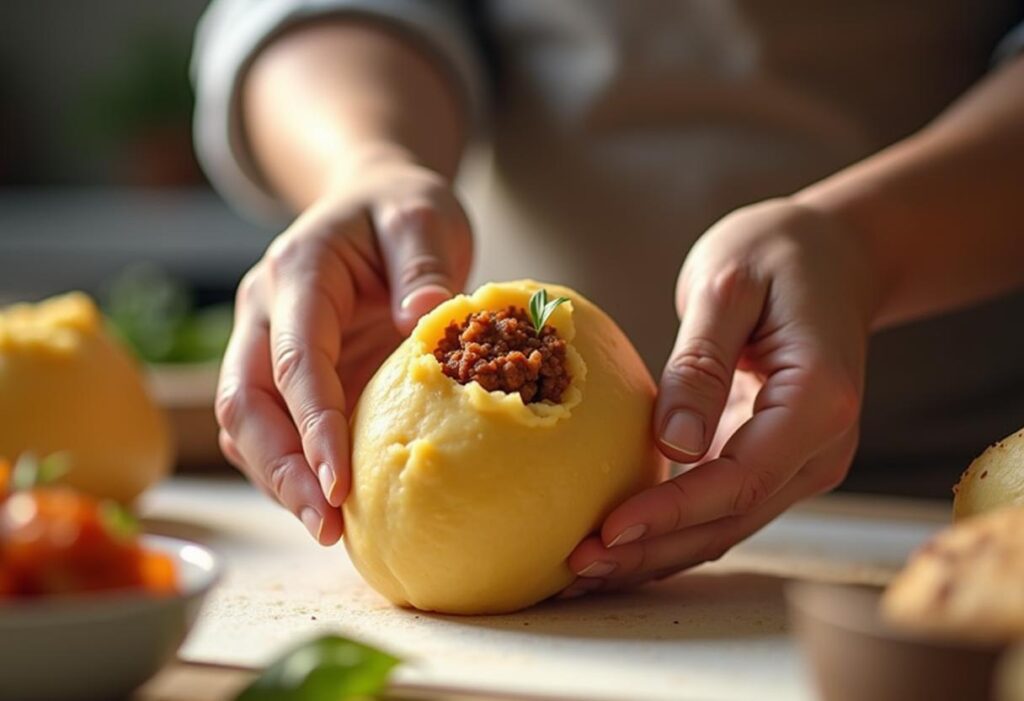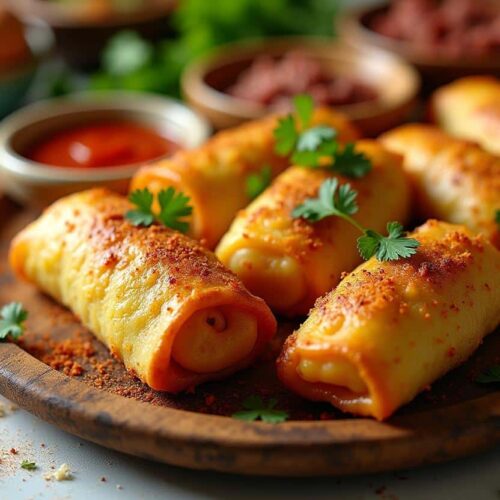Ugh, hasn’t this happened to you? You’re dreaming of golden, crispy potato balls, maybe humming some Sinatra while the oil heats up… and then BAM. You slide those beautiful Rellenos de Papa in, only to watch them crumble into a sad, greasy mess. Mamma mia, it’s the worst! My kids love anything crispy, and when these fail, even my goofy husband’s history puns can’t cheer me up. These Peruvian stuffed potatoes are pure comfort food, like a warm hug from Nonna, but man, they can be tricky. So, why are your rellenos de papa falling apart?
Don’t you worry your pretty little apron! After a few trial-and-error batches (and maybe a glass of Pinot Grigio to soothe my nerves), I’ve figured out the secrets. I’m going to walk you through my hard-earned tips, from picking the right spuds to getting that glorious, stays-together fry. We’ll get those rellenos golden, crispy, and totally intact! And hey, if you’re curious about their journey, you might wonder what country papas rellenas are from – they have quite the story!
Ingredient Breakdown: The Foundation of Perfect Rellenos
Okay, first things first, let’s chat ingredients. Nonna always said, “Good food starts with good stuff!” and she wasn’t wrong. Getting the building blocks right for your rellenos de papa is mission critical if you want them to hold together and taste, well, buono ! It all begins with the star of the show…
Choosing the Right Potatoes
Think of the potato part like a cozy, edible blanket hugging that yummy filling. You need a potato that gets fluffy and mashable, not one that stays firm. Go for starchy types like Russets (my fave!) or Yukon Golds. They mash up beautifully, creating a smooth, kinda dough-like texture that’s easy to work with. Steer clear of waxy potatoes like red potatoes or fingerlings for this job – they’re great for roasting or salads, but here they’ll give you a lumpy, frustrating mess. Want the full lowdown on spuds? This guide breaks it down: Different Potato Varieties Explained.
The Filling: Flavor and Consistency
Inside that potato blanket is where the party happens! Traditionally, it’s filled with picadillo – a savory, seasoned ground beef mixture. We’re talking onions, garlic, warm spices like cumin and paprika… sometimes little salty olives, sweet raisins, or bits of hard-boiled egg join the fun. Delizioso! The absolute key here? Make sure your filling is packed with flavor (don’t be shy!) but not too wet . A soupy filling is a one-way ticket to Soggy Town and makes your rellenos likely to weep or fall apart. Drain that meat well, folks!
Binding it All Together: The Role of Eggs and Flour
So, how do we make sure that potato blanket stays tucked in? Eggs and a little flour are your best friends here. An egg mixed into the mashed potatoes acts like edible glue, adding richness and helping everything stick together. A tablespoon or two of flour helps absorb any sneaky extra moisture, giving the potato mixture better structure. You want it to feel kind of like soft Play-Doh – easy to shape, not sticky or crumbly.
Step-by-Step Guide to Relleno Assembly and Frying
Alright, ingredients assembled? Apron on? Maybe some Dean Martin playing? Let’s DO this! Making rellenos isn’t complicated, but paying attention to a few key steps makes all the difference between frustration and fried perfection. Follow along, and we’ll get there together!
Perfectly Cooked Potatoes
Job number one: cook those spuds right. Boiling works great – peel ’em, chop ’em (they cook faster!), cover with cold water, bring to a boil, and simmer until just fork-tender. That means a fork slides in easily, but they aren’t falling apart into mush. Overcooked = watery potatoes = disaster. Drain them SUPER well (like, let them sit in the colander for a few minutes) and let them cool down a bit before you mash. Steam is moisture!
Shaping the Rellenos
Here’s the hands-on fun! Once your mashed potatoes (mixed with egg and maybe a touch of flour) are cool enough to handle, lightly moisten your hands with water or oil – this stops the potato from sticking. Grab about a 1/2 cup of the mixture, flatten it into a circle in your palm, and make a little dent in the middle – like a tiny potato nest! Spoon in a tablespoon or two of your cooled picadillo filling. Resist the urge to overstuff! Too much filling makes sealing impossible and leads to blowouts in the fryer. Trust me on this.
Sealing and Breading
Gently bring the edges of your potato circle up and over the filling, pinching them together tightly to seal everything inside. No gaps allowed! Roll it gently between your palms to smooth it into a nice oval or football shape. Now, for the crispy armor! Set up a breading station: one shallow dish with flour, one with beaten egg (a splash of water helps), and one with breadcrumbs (panko = extra crunch!). Roll the relleno first in flour (shake off excess), then dip completely in the egg, and finally, coat generously in breadcrumbs. Pat them on gently so they stick.
Frying to Golden Perfection
Heat up your frying oil! Pour about 2-3 inches of neutral oil (like canola or vegetable) into a heavy-bottomed pot or Dutch oven. Heat it to between 350°F and 375°F (175-190°C). A thermometer is your best friend here! Too cool = soggy rellenos. Too hot = burnt outside, cold inside. Test with a tiny scrap of bread – if it turns golden and sizzles happily in about 60 seconds, you’re good to go. Carefully lower 3-4 rellenos into the hot oil using a slotted spoon. Don’t overcrowd the pot! Fry, turning gently once or twice, for about 3-5 minutes per side, until they’re a beautiful, even golden brown. Ah, the sizzle! Transfer them to a wire rack set over paper towels to drain. Serve warm with your favorite dip – maybe something from these delicious sauce recipes?
Nutrient Amount
| Nutrient | Amount (per 100g) |
|---|---|
| Calories | 250 |
| Total Fat | 15g |
| Saturated Fat | 5g |
| Cholesterol | 50mg |
| Sodium | 300mg |
| Total Carbohydrates | 25g |
| Dietary Fiber | 2g |
| Sugars | 2g |
| Protein | 8g |
Note: Just keep in mind, these numbers are estimates! It all depends on your specific ingredients and how you cook ’em.
Rellenos de Papa
Ingredients
For the Potato Mixture:
- 2 lbs Starchy potatoes Russet or Yukon Gold
- 1-2 Large Eggs for binding
- 2-4 tablespoons All-purpose flour for binding and additional absorption
- Salt to taste
For the Picadillo Filling:
- 1 lb Ground beef
- 1 medium Onion finely chopped
- 2-3 cloves Garlic minced
- 1 teaspoon Cumin
- 1 teaspoon Paprika
- Salt and pepper to taste
- Optional: Olives raisins, hard-boiled eggs
For Breading:
- ½ cup All-purpose flour
- 2 Large Eggs beaten
- 1-2 cups Breadcrumbs
For Frying:
- Vegetable Oil enough for deep frying (2-3 inches)
Optional Garnishes:
- Salsa Criolla
- Aji Amarillo Sauce
- Chopped Cilantro
Instructions
- Cook the Potatoes: Boil or steam the potatoes until fork-tender. Drain well and let them cool slightly.
- Prepare the Filling: While the potatoes are cooking, brown the ground beef in a skillet. Add the onions and garlic and cook until softened. Stir in cumin, paprika, salt, and pepper. Add optional ingredients like olives, raisins, or hard-boiled eggs. Make sure the filling is not too wet.
- Mash the Potatoes: Mash the cooked potatoes until smooth. Mix in 1-2 eggs, flour, and salt. The mixture should resemble playdough – moldable but not sticky.
- Shape the Rellenos: Take about 1/2 cup of the potato mixture and flatten it into a disc in your palm. Make a well in the center. Spoon 2 tablespoons of picadillo into the well. Gently bring the edges of the potato disc together to enclose the filling, pinching to seal. Shape into an oval or football shape.
- Breading: Roll the relleno in flour, then dip it in beaten egg, and finally, coat it generously with breadcrumbs.
- Fry the Rellenos: Heat oil in a deep pot or skillet to 350-375°F (175-190°C). Carefully place the rellenos in the hot oil and fry for 3-5 minutes per side, until golden brown and crispy. Do not overcrowd the pan.
- Drain and Serve: Remove cooked rellenos with a slotted spoon and place them on a wire rack or paper towel-lined plate to drain excess oil. Serve hot with optional garnishes like salsa criolla or aji amarillo sauce.
Notes
- Use starchy potatoes like Russets or Yukon Golds for a smooth mash.
- Make sure your picadillo filling is not too wet to prevent soggy rellenos.
- Damp hands help prevent the potato mixture from sticking during shaping.
- Double breading ensures extra crispiness.
- Maintain the oil temperature between 350-375°F (175-190°C) for optimal frying.
- Do not overcrowd the pan when frying. Fry in batches.
- Chilling the potato mixture can make it easier to handle.
Tips and Tricks for Relleno Success
Okay, so you followed the recipe, but your rellenos are still acting up? Hey, it happens to all of us! Don’t throw in the towel (or the potato!). Let’s troubleshoot and share a few extra tricks I’ve picked up along the way to guarantee relleno glory:
Troubleshooting Common Issues
- Rellenos crumbling while shaping: This is usually a sign your potato mix is too wet. Did you maybe overcook the potatoes? Or not drain them well enough? Was your filling a bit watery? Try mixing in another tablespoon of flour. Chilling the mashed potato mixture in the fridge for 30 minutes can also work wonders for firming it up!
- Rellenos bursting open mid-fry (The Horror!): Okay, deep breaths. This could be a few things:
- Overstuffed: I know, the filling is amazing, but too much makes sealing tough. Be modest!
- Poor Seal: Pinch those edges together like you mean it! Any tiny gap is an escape route for that hot filling.
- Oil Temp Tantrums: If the oil’s way too hot, the outside cooks instantly while the inside rapidly expands and pop ! Keep that temp steady.
- Soggy, Sad Rellenos: This almost always means the oil wasn’t hot enough. When the oil is too cool, the food just soaks it up instead of getting crispy. Use that thermometer (350-375°F is the sweet spot!) and fry in small batches so the oil temperature doesn’t drop too much. Drain them on a wire rack, not just paper towels, to keep the bottoms crispy.
We all make frying mistakes sometimes! Check out this guide for common oopsies: Common Deep-Fried Food Mistakes (Ignore the running link title, the content applies!).
Customization and Variations
- Veggie Power!: These beauties aren’t just for meat-eaters! Make a killer vegetarian filling with sautéed mushrooms, spinach, corn, peppers, onions… whatever makes you happy! Or go cheesy – tucking a cube of mozzarella or queso fresco inside is heaven .
- Spice World: Feel free to play with the filling spices! Add some chili powder, smoked paprika, or even a pinch of cayenne for heat. Want authentic Peruvian flavor? A little aji amarillo paste is amazing. Find out more about this sunshine chili here: Aji Amarillo Paste Information. You can even draw inspiration from other Latin dishes, like exploring ideas from these soft taco recipes and tips for flavor combinations.
- Egg-cellent Addition: A classic move is putting a slice or wedge of hard-boiled egg inside with the picadillo. Adds great texture and richness! Nonna would approve.
Frequently Asked Questions (FAQ)
Got questions? I bet you do! Let’s tackle some common head-scratchers about making perfect rellenos de papa:
Why are my fried potato balls falling apart?
This is the million-dollar question, right? There are several reasons why your fried potato balls (rellenos de papa) might be falling apart. The most common culprits are:
Too much moisture: Either your potatoes were overcooked and absorbed too much water, or your filling was too wet.
Not enough binder: You might need to add more egg or flour to your potato mixture to help it hold its shape.
Shaping issues: If they’re not sealed properly, the filling can leak out during frying, causing the whole thing to fall apart.
Oil temperature: If the oil isn’t hot enough, the rellenos will absorb too much oil and become soggy. If it’s too hot, they might burst.
Why are my potatoes falling apart?
If your potatoes are falling apart during cooking, you’re likely overcooking them. Potatoes, especially starchy ones, break down when they’re cooked for too long. They should be fork-tender, meaning you can easily pierce them with a fork, but they shouldn’t be mushy. Also, make sure you’re using the right type of potato. Waxy potatoes are better for salads or dishes where you want them to hold their shape. For mashing, stick to starchy varieties like Russets or Yukon Golds.
What are rellenos de papa made of?
Rellenos de papa are essentially seasoned mashed potatoes that are formed into an oval shape, filled with a savory ground beef mixture (picadillo), then breaded and deep-fried. The basic ingredients are:
Potatoes: Starchy potatoes like Russets or Yukon Golds
Ground beef: For the picadillo filling
Onion, garlic, spices: To flavor the picadillo
Eggs: To bind the potato mixture and for the egg wash
Flour: To help bind the potato mixture and for breading
Breadcrumbs: For the crispy outer coating
Oil: For deep-frying
What to eat with papas rellenas?
Papas rellenas are delicious on their own, but they’re even better with some tasty accompaniments! Here are a few ideas:
Salsa Criolla: This classic Peruvian onion relish is the perfect partner for papas rellenas. It’s made with thinly sliced red onion, lime juice, cilantro, and aji amarillo (Peruvian yellow chili pepper).
Aji Amarillo Sauce: This creamy, slightly spicy sauce is another great option. You can find it in Latin American grocery stores or make your own.
Ensalada Rusa: Similar to potato salad, but usually includes beets, carrots, and peas.
A simple green salad: A light, refreshing salad can help balance out the richness of the fried rellenos.
Conclusion
So there you have it, my foodie friends! The secrets to conquering the Relleno de Papa dilemma. No more watching your beautiful creations fall apart in the fryer! It really comes down to the right potatoes, managing moisture, getting a good seal, and frying smart. It might take a practice batch (no shame in that!), but you CAN achieve that perfect, crispy, golden exterior holding onto that delicious, savory filling.
I really hope these tips help you feel confident and ready to give these amazing stuffed potatoes another try (or your first try!). Remember, cooking is about joy, learning, and sharing delicious food. Even my picky eater son can sometimes be convinced by a perfectly fried relleno (the crispy factor helps!), and my daughter loves helping shape them (even if they look a little lopsided!). If you want to try a slightly different take, check out this Papas Rellenas Recipe Chilean Style. Have fun in the kitchen! Let me know how yours turn out in the comments below – share your wins, your questions, your favorite fillings! Buon appetito!





